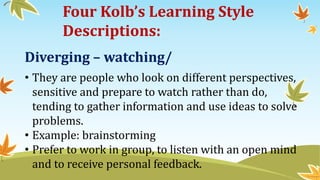Kolbs learning-theory-group-4 revised
- 1. Kolb’s Learning Theory Prepared by: De Castro, Mary Rose Ann Festijo, Ma. Thea Perpetua, Ser August Zoleta, Adrian
- 2. The Theorist: David Kolb • An American educational theorist born in 1939. •Kolb earned his BA from Knox College in 1961 and his MA and Ph.D. from Harvard University in 1964 and 1967 respectively, in social psychology.
- 3. •He is mainly credited for his Experiential Learning Model (ELM) and his Learning Style Inventory (LSI). •In 1984, David A. Kolb, published a ground breaking book entitled Experiential Learning: experience as the source of learning and development. (Englewood Cliffs, Prentice Hall, 1984).
- 4. •It essentially exposed the principle that a person would learn through discovery and experience. •The reason of the theory is called “Experiential" is its intellectual origins are taken from the experiential work of Lewin, Piaget, Dewey, Freire and James, forming a unique perspective on learning and development.
- 5. Experiential Learning Theory (ELT) • provides a holistic model of the learning process and is a multi-linear model of adult development, both of which are consistent with what we know about how we naturally learn, grow, and develop.
- 6. •The theory is called "Experiential Learning" to emphasize the central role that experience plays in the learning process. •Kolb’s experiential learning theory is a holistic perspective that combines experience, perception, cognition, and behavior.
- 8. Kolb’s Cycle of Experiential Learning
- 9. CONCRETE EXPERIENCE (OR “DO”) •The first stage, concrete experience (CE), is where the learner actively experiences an activity such as a lab session or field work. REFLECTIVE OBSERVATION (OR “OBSERVE”) •The second stage, reflective observation (RO), is when the learner consciously reflects back on that experience.
- 10. ABSTRACT CONCEPTUALIZATION (OR “THINK”) •The third stage, abstract conceptualization (AC), is where the learner attempts to conceptualize a theory or model of what is observed. ACTIVE EXPERIMENTATION (OR “PLAN”) •The fourth stage, active experimentation (AE), is where the learner is trying to plan how to test a model or theory or plan for a forthcoming experience.
- 11. Thinking about and watching people making basket. Understanding the theory and having a clear grasp of basket making concept Receiving practical tips and techniques from the expert through seminar, trainings Properly apply by handcrafted raw materials and make a basket Livelihood project “Basket Making”
- 12. Kolb’s Learning Styles • Kolb explain that different people naturally prefer a certain single different learning style. • Factors that influence a person’s preferred style. For example, social environment, educational experiences, or a basic cognitive structure of the individual. • A typical presentation of Kolb’s two continuums • Processing Continuum (how we approach the task) East and west • Perception Continuum (our emotional response or how we think or feel about it) north-south
- 14. Four Kolb’s Learning Style Descriptions: Diverging – watching/ • They are people who look on different perspectives, sensitive and prepare to watch rather than do, tending to gather information and use ideas to solve problems. • Example: brainstorming • Prefer to work in group, to listen with an open mind and to receive personal feedback.
- 15. Four Kolb’s Learning Style Descriptions: Assimilating – watching and thinking • Ideas and concepts are more important than people. • These people require good clear explanation rather than a practical opportunity. • In formal learning situations, people with this style prefer readings , lectures, exploring analytical models and having time to think things through.
- 16. Four Kolb’s Learning Style Descriptions: Converging – doing and thinking • People with this learning style can solve problems and will use their learning to find solutions in practical issues. • They prefer technical task and problems rather than social and interpersonal aspects. • People with a converging style like to experiment with new ideas, to simulate and to work to practical applications
- 17. Four Kolb’s Learning Style Descriptions: Accommodating – doing and feeling • This learning style is “hands-on” and relies on intuition rather than logic. • These people use other people’s analysis and prefer to take a practical and experiential approach. • They commonly act on “gut” instinct rather than logical analysis. • This is prevalent within the general populations.
- 18. Matrix of Kolb’s Learning Style Active Experimentation (Doing) Reflective observation (Watching) Concrete Experience (Feeling) Accommodating (CE/AE) Diverging (CE/RO) Abstract Conceptualization (Thinking) Converging (AC/AE) Assimilating (AC/RO)
- 19. Educational Implications: • The learning style could be used by teachers to critically evaluate the learning provision typically available to students and to develop more learning opportunities. • Individuals can be helped to learn more effectively by the identification of their lesser preferred learning styles and strengthening this through the applications of the experiential learning cycle. • Activities and material should be developed in ways that draw on abilities from each stage of the experiential learning cycle and take the students through the whole process in sequence.
- 20. REFERENCES • Kolb, David A. 1984. Experiential Learning: Experience as the Source of Learning and Development. Prentice- Hall, Inc., Englewood Cliffs, N.J. • Kolb, D. A. (2014). Experiential learning: Experience as the source of learning and development. FT press. • Kolb, D. A. (1976). The Learning Style Inventory: Technical Manual. McBer & Co, Boston, MA. • Kolb, D. A. (1981). Learning styles and disciplinary differences. The modern American college, 232-255. • https://www.simplypsychology.org/learning-kolb.html



















